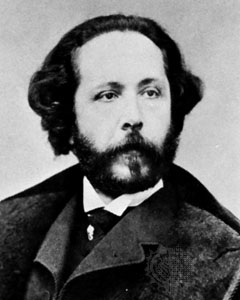- Profession: Composer
- Residences: Spain, France
- Relation to Mahler:
- Correspondence with Mahler:
- Born: 27-01-1823 Rijsel/Lille, France.
- Died: 22-04-1892 Paris, France.
- Buried: 00-00-0000 Pere Lachaise cemetery, Paris, France.
Édouard-Victoire-Antoine Lalo was a French composer. Easily his most celebrated piece is his Symphonie espagnole, a popular work in the standard repertoire for violin and orchestra. Lalo was born in Lille (Nord), in northernmost France. He attended that city’s conservatoire in his youth. Then, beginning at age 16, Lalo studied at the Paris Conservatoire under François Antoine Habeneck. Habeneck conducted student concerts at the Conservatoire from 1806 onwards and became the founding conductor of the Orchestre de la Société des Concerts du Conservatoire in 1828. (Berlioz, in his memoirs, denounced Habeneck for incompetence in conducting Berlioz’s own Requiem.)
For several years, Lalo worked as a string player and teacher in Paris. In 1848, he joined with friends to found the Armingaud Quartet, playing viola and later second violin. Lalo’s earliest surviving compositions are songs and chamber works (two early symphonies were destroyed).
Julie Besnier de Maligny, a contralto from Brittany, became his bride in 1865. She aroused Lalo’s early interest in opera and led him to compose works for the stage, of which Le Roi d’Ys is the most notable. Unfortunately, these works were never really popular; despite their originality, they incurred considerable criticism for being allegedly too progressive and Wagnerian. This led Lalo to dedicate most of his career to the composition of chamber music, which was gradually coming into vogue for the first time in France, and works for orchestra.
Although Lalo is not one of the most immediately recognized names in French music, his distinctive style has earned him some degree of popularity. Symphonie espagnole for violin and orchestra still enjoys a prominent place in the repertoire of violinists and is known in many classical circles simply as “The Lalo”. Every now and then Lalo’s Cello Concerto in D minor is revived. His Symphony in G minor was a favorite of Sir Thomas Beecham (who recorded it) and has been occasionally championed by later conductors too.
Lalo’s idiom is notable for strong melodies and colourful orchestration, with a rather Germanic solidity that distinguishes him from other French composers of his era. Such works as the Scherzo in D minor, one of Lalo’s most colorful pieces, might be considered appropriate embodiments of his distinctive style and strong expressive bent.
The aforementioned Le roi d’Ys, an opera based on the Breton legend of Ys, is Lalo’s most complex and ambitious creation. (This same legend inspired Claude Debussy to compose his famous piano piece, La cathédrale engloutie.) For many years Le Roi d’Ys was considered unperformable, and it was not staged until 1888, when Lalo was 65 years old. Eight years earlier, he became a member of the Legion of Honour. He died in Paris in 1892, leaving several unfinished works, and was interred at the Père Lachaise Cemetery.
Lalo’s son Pierre (06-09-1866 – 09-06-1943) was a music critic who wrote for Le Temps and other French periodicals from 1898 until his death.

